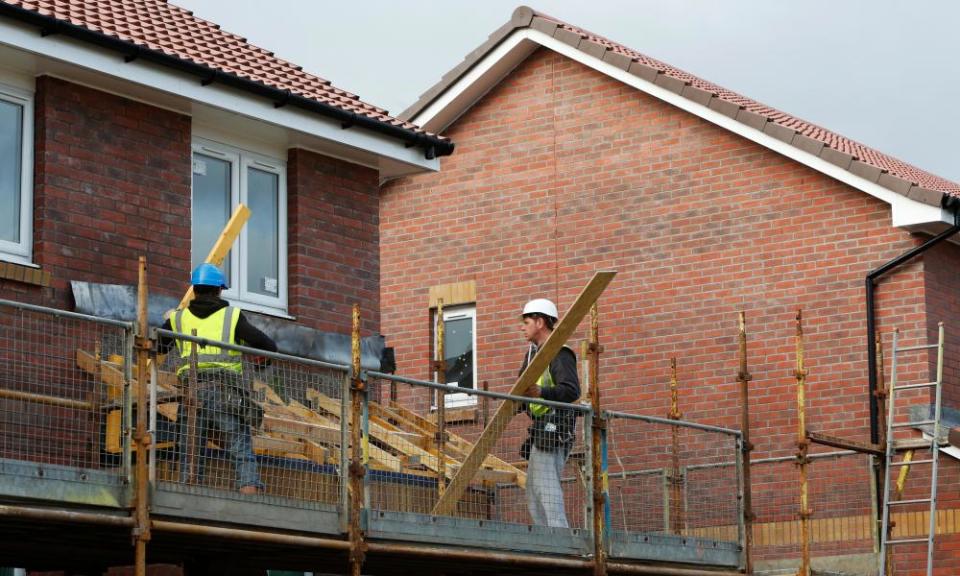Buyers of brand-new homes face £20,000 bill to make them greener

Householders buying brand new homes in the next four years are likely to find an unpleasant surprise awaiting them in the future: homes built today will have to be retrofitted with energy efficiency measures and low-carbon technology, at an average cost of more than £20,000.
The extra costs will amount to more than £20bn for the whole of the UK, if the government’s targets of building 300,000 new homes a year are met. Critics say the costs could have been avoided if ministers had agreed to bring in low-carbon standards sooner.
The government this week set out proposals to change building regulations to reduce greenhouse gas emissions, but declined to bring forward its proposed future homes standard from the scheduled 2025 commencement date, disappointing advocates of greener homes.
Building a new house with high energy efficiency standards and a heat pump instead of a gas boiler costs about £4,800 more than building to current standards. However, building to current standards and then retrofitting the house with the same would cost an average of £26,300, or about £21,500 more than installing the technology in the first place, according to an analysis by the Labour party of data from the Committee on Climate Change (CCC).
John Gummer (Lord Deben), chair of the CCC, has warned repeatedly that at least 1m homes built in recent years will need to be refurbished at large expense, as they were built to inferior standards of efficiency.
All UK homes will need to be brought up to high standards of efficiency and equipped with low-carbon heating in place of gas boilers if the government is to meet its target of net zero greenhouse gas emissions by 2050.
The 2025 commencement date for the government’s future homes standard is a decade after the zero carbon homes standard, which the last Labour government had scheduled to come in from 2015. The government scrapped that, after some of the construction industry lobbied against the standard, arguing it adds to the cost of a new home.
Proponents of green building say the cost of equipping a new home to a low-carbon standard is small compared with the overall cost of a house or flat, and homes equipped to the higher standard cost less to run.
Labour called on the government to take swifter action, and said the 10-year delay to a requirement to build homes to a low-carbon standard would cost £45bn in total upgrade costs in the future.
Thangam Debbonaire, shadow housing secretary, said: “The Tories’ short-term approach to the climate is hitting families and the economy. Their irresponsible decision to scrap the zero carbon homes policy will have wasted £45bn by the time the Tories have scrambled to catch up with Labour’s policy.”
Labour has also estimated that scrapping the warm front home insulation scheme in 2013 cost households £3.7bn in additional energy bills, and produced an extra 14.6m tonnes of carbon dioxide by 2017.
Debonnaire added: “Families will spend years in homes [that] are colder and more expensive to heat. Every year of delay is costing billions of pounds and pumping millions of tonnes of carbon into the atmosphere. The government needs to wake up to the importance of warmer, more efficient and sustainable homes.”
A spokesperson for Friends of the Earth said: “Saving money and combating the climate crisis should merrily go hand in hand but the government seems to think otherwise. We would have already been building low-carbon homes if it weren’t for the Conservative government scrapping the standards and capitulating to the lobbying of the profit-hungry high-volume house-builders. Delaying the future homes standards will lead to money being wasted while homes continue to run on planet-wrecking gas heating.”
Julie Hirigoyen, chief executive at the UK Green Building Council, said: “After a long wait, the government’s response to the future homes standard consultation brings much-needed clarity to our industry. We are pleased to see confirmation that the future homes standard will mean new homes will have carbon dioxide emissions 75%-80% lower than those built to current building regulations – though it’s regrettable that the standard won’t be implemented till 2025, despite it being widely trailed that it would be brought forward to 2023.”
Housebuilders have said they are in favour of higher standards, but warned of a potential shortage of workers. Brian Berry, chief executive of the Federation of Master Builders, said: “Small- to medium-sized house builders must be at the heart of plans to improve the sustainability, quality and design of our homes, but they need greater support to build homes and tackle climate change. Bringing forward the future homes standard must be balanced with addressing the construction skills shortage, so that local builders can employ quality local tradespeople on site. One in three small to medium house builders said a lack of skilled workers would be a significant constraint on their activity over the next three years.”
The government has said bringing in the future homes standard from 2025 will mean new homes built from that date will produce between 75% and 80% less carbon dioxide than homes built to current specifications, and that these homes would be “zero carbon ready”, to become fully zero carbon at a future date without further retrofitting work. Before 2025, building regulations will be strengthened so that homes built or renovated in the interim will need to meet higher standards than those now in place.
A government spokesperson said: “We are improving the quality of housing across the country by ensuring new homes adhere to strict energy efficiency standards, which will help us meet our target of net zero emissions by 2050. Retrofitting homes can have a positive impact on both jobs and the climate, which is why we are investing £2bn in the green homes grant scheme. This will help with the costs of energy efficiency upgrades in 600,000 English homes, so households can cut their bills and emissions.”

 Yahoo Finance
Yahoo Finance 